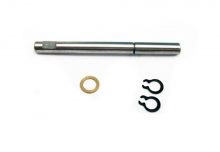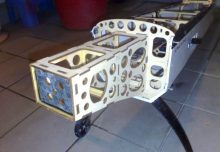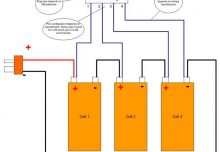High Performance 3D/Freestyle flying requires four critical considerations for battery packs which are; consistent power throughout the entire duration of the sequence, light enough to be within the prescribed AWT of the model to retain design flight characteristics, properly sized to accommodate the demands of the drive system and a long trouble free service life.
Lithium Polymer packs (Lipo) presents some unique challenges to high performance 3D/Freestyle flying and in certain aspects, more so than other forms of fixed-wing application. Apart from the 4 critical considerations mentioned above, they require adequate ventilation for cooling, a secure mounting method, adequate discharge levels to meet the application and a structured approach to charging, maintenance, handling and storage.
Unlike sports and scale applications, sizing, matching and selection of Lipo packs for 3D/Freetyle applications is no simple task by any means and in some aspects more critical. There are many mind boggling permutations to consider and as such should need to be taken into account from a global perspective. To the uninitiated this is indeed very confusing and sometimes dangerous and thus spawning irrational fears about Lipos. Lithium technology is probably the most widely used form of power packs today. It usage is not specific to just RC alone and can found in contemporary household electronics ranging from cell phones, laptops, MP3 players, cameras, PDAs etc. Therefore the technology like everything else, if used properly is safe.
The Basics:- Watt’s that all about, Amp-feee!
We shall start with the common terminology associated with batteries:
Voltage
Voltage is the electrical potential or electromotive force and is expressed as Volts(V). Taking the common analogy of water in a pipe, voltage can be visualized as water pressure and hence Voltage determines how fast electricity travels through an electrical circuit As such Voltage is sometimes called potential difference.
Current
Current is the amount of electricity flowing and is expressed as Amps (A). Current in the same fluid analogy could be imagined as the rate of water passing a given point; that is the volume of water passing a point at a given time.
Resistance
Resistance is a ratio of the amount to which an object opposes an electric current through it and is expressed asOhms. Resistance can be visualized in the fluid example above as having the flow rate of water restricted by the width of the pipe. The thicker the pipe the higher the flow rate of water it’s able to carry.
Power (Watts)
Power is defined as the rate energy is produced or consumed and is expressed as Watts (W). Power in the mechanical world is also expressed as horsepower (hp) where 1hp =746.26W. It needs to be noted that heat is also expressed in Watts and as such one need to be cognizant about the rated watts of a motor. A motor’s rated Watts does not necessarily mean that would be the actual rated power output at the motor shaft. In cases where motors run hot, there is a significant amount of power being as wasted as heat so what the motor consumes is not equal to what it outputs.
Battery Capacity (Amp-Hours or Miliamp-hours)
Battery capacity is the amount of electric charge stored in a battery. This is expressed in Amp hours (Ah) for a large battery like in a car or Miliamp hours (mAh) for small batteries like the ones we use in our EP models. In the case of models, the milliamp hour figures stated simply denotes that if the battery is allowed to be discharged at the rate of current stated by the pack, the pack will completely be discharged in 1 hour. In simple terms, the battery capacity can be imagined as the volume of water in a tank; say in this example is 200 gallons. So, if the tank is connected to a pipe that discharges at a rate of 200 gallons per hour, it would then take an hour to completely empty the tank. Similarly, if we use the same pipe to fill the tank at 200 gallons per hour, it would also take an hour to fill it back and we can relate that to the Charging Rate of 1C.
Charging Rate (C)
The charging current is the maximum current or Amps the battery can be safely charged at. Most regular Lipo packs can be safely charged at a rate up to1C; that is the amount of current indicated by the numeric value stated on by the battery capacity meaning that for example; a regular 2200mAh Lipo pack with a 1C charge rate can be safely charged at 2.2A. However there are now new rapid charge packs that have the ability to be safely charged at higher rates e.g. the PA 2200mAh V2 packs which can be safely charged at 2C (4.4A).
The Discharge Rate (C-Rating).
The Discharge C-Rating is the rate at which the pack can be safely discharged. It is expressed in multiples of the packs charging current and hence multiples of “C”. What this means is the amount of amps the pack is able to deliver safely on demand without damaging the battery. To explain what the C-Rating means is in simple terms, is C-Rating can be imagined as the number of water pipes connected to a tank; meaning the more pipes connected, the higher the rate of water that can be discharged at given time. Similarly the bigger the C-Rating the more current the battery is able to deliver and thus provides a much better acceleration and power to a point where it is limited by the motor.
There are two types C-Ratings for a pack to be aware of:
- Continuous Discharge Rating:- This maximum current the pack is able to deliver continuously until it depletes. This is where the battery is able to sustain delivering the rated current for the entire flight without sustaining permanent damage or premature deterioration. Therefore it is very important to size the packs to remain at or below the continuous discharge rate for most of the flight. Sizing to about 80% of the maximum continuous discharge rates helps prolong the life of the pack.
- Burst Rating:- The peak momentary maximum current delivered by the pack for a very short period (10sec). This is where the throttle is gunned pass the maximum continuous discharge rates for a short period time to safely provide a short burst of maximum power and acceleration. The burst period (10sec) stated in the pack or its maximum burst current should never be exceeded. Packs shouldnever be selected to operate in their burst mode for an extended period of time.
In the case of the PA 2200mah 20C-30C V2 packs, it means that the rated Continuous C-Rating is 44A with the Burst C-Rating of 66A (for 10sec).
Low Voltage Cutoff (LVC)
LVC is a safety feature built into Electronic Speed Controllers (ESC) intended to prevent the pack from being over-discharged and going below the minimum safe voltage of 3V per cell and possibly sustaining permanent damage. It cuts power to the motor leaving power only to the receiver and servos to allow a safe landing in a controlled manner.
Lipo Charger
Lithium Polymer cells have a charging characteristic that is vastly different from NiMH or NiCad and as such require chargers specific for them. We recommend using reputable Lipo chargers to ensure the packs are charged safely.
Balancing Plug
A balancing plug is a special socket wired to individual cells of the battery pack to allow balancers to be connected to. There are many formats of balancer plugs and not all are compatible to all balancers and in some extreme cases are brand specific requiring specific brand balancers. The most common balancer plug format used in a majority of Lipos today however is the JST.
Balancing
Balancing is a maintenance action done to equalize the voltage imbalance between the cells of a battery pack caused by cumulative uneven discharge and charge cycles during its life in service, overheating due to inadequate ventilation, over discharge or uneven ageing of individual cells within a pack. Balancing is done through a balancing charger or an add-on Lipo balancer. The balancer allows individual cells within a Lipo pack to be charged and discharged individually to attain a uniform voltage. This prevents the individual cells from being overcharged or over-discharged shortening the life of the pack.
Battery Connector
This is the gendered socket and plug connector to make a safe electrical connection between the battery and the Electronic Speed Controller (ESC). Most connectors are gendered to prevent accidental sort circuits and reverse polarity. There are many formats currently available today. However the most important criteria in selecting a suitable battery connector is the current carrying capacity and reliability. There have been several cases where “clone copies” of the Ultra Deans Connectors have failed during flight or have caused intermittent connection problems affecting the RX and ESC. From a superficial stand point, clone and original connectors may appear identical, however there is more to this than mere appearance. It is thequality and purity of the conducting material used in the connector that is critical. Most connectors are either copper or aluminum. High purity copper offers the best conductivity (99% pure) and its purity affects its internal resistance and therefore its current handling capacity. However pure copper is an expansive commodity and as such cheaper clone connectors tend to employ either recycled copper or copper of lower impurity or in the worst case using metals that are electroplated with copper which causes premature connection failures due to cathodic corrosion caused by two dissimilar metals coming into contact. Therefore it is prudent to invest in good original brand connectors upfront to minimize the potential hazards.
Series (S)
Series in battery terms is where the cells are battery pack are strung end to end to increase the voltage. One cell terminal is connected to the opposite terminal of the next in a positive-negative-positive-negative-positive-negative series chain that provides a total voltage that is made up of the sum of all the cells in that chain. A 3S pack simply means that the pack is made up of 3 cells connected in series and therefore the voltage of a 3S pack is 3.7V+3.7V+3.7V= 11.1V. Identical Packs can also be strung in series to increase the voltage.
Parallel (P)
Parallel in battery terms is where the individual cells of a battery pack are strung side by side to increase its capacity and current. One cell terminal is connected to the same terminal of the next cell in a positive-positive and negative-negative. A 3P pack simply means that there are 3 cells connected in parallel and say if the pack is 1000mah each, 3 cells connected in parallel is 1000mAh+1000mah+1000mAh= 3000mAh.
In most cases packs are denoted by their S and P for example a 3S2P 3000mah 11.1V Pack simply means that the pack is made up of 2 sets of 3 cells of 1500mah connected in series that are then connected together in parallel. Parallel connections are done to either increase the flight time or to spread the current drawn by the motor to individual packs or cells in order to remain within their safe continuous discharge limits.
SAFETY GUIDELINES FOR CHARGING LIPO PACKS
Charging cells is probably the most hazardous part of using Lipo batteries and is the primary cause of a majority of Lipo related incidences and the source of many horror stories anyone new to EP would probably hear first. However, a majority of these incidences are actually attributed by the lack of knowledge of the user as opposed to the inherent nature of the Lipo itself. As mentioned before, Lipos are no more dangerous than other types of batteries and what makes it dangerous, like anything else is the lack of knowledge in using and caring for them. As the saying goes a little knowledge is a dangerous thing. It is important to know that Lipo cells are different from NiCAD or NiMH cells and therefore must be charged differently. Therefore Lipos require a special charger specifically designed to charge them and thus the warning below is the most important safety guideline to remember.
IMPORTANT!
Under any circumstances absolutely never attempt to charge Lipo cells using a NiCad or NiMH battery charger or set the battery type of a multi-charger in the NiCad, NiMH, PB or any other mode apart from Lipo. Always check and confirm the battery type and number of cells before charging.
Why is this warning so important?
Lipo chargers uses a Constant Current (CC)+Constant Voltage (CV) charging profile. What this means is that the charger works two modes while charging Lipos. During the initial charging phase (when it starts), it charges the Lipo using a fixed amount of current (thereby called Constant Current which is the amount of current you have set on your charger) until the pack voltage reaches 4.0V per cell. One can actually observe this mode coming into play by observing the amps displayed on the charger’s LCD panel (If it has one) initially increasing to a point where it then remains constant a few minutes after pressing the start button. Once the charger reaches the point where the pack is at 4.0V per cell, it switches over the Constant Voltage charging mode (CV) to deliver a fixed voltage and continues to charge the pack with a small amount of current until the pack reaches full charged. This is where it could be observed on the LCD display indicating a drop in the charging current into a mere trickle at the last but long bit of the charging process. NiCad/ NiMh chargers and multi-chargers set to NiCad/NiMh mode on the other hand uses a delta peak detection charging profile and since Lipos do not have delta peaks, the charger in this mode is unable to detect it to terminate the charging and thus continues to over-charge them with frequent catastrophic results. As such it becomes a safety hazard by unintentionally turning them into incendiary devices; the source of many Lipo related horror stories.
Here are the important Mandatory Safety rules for charging Lithium batteries (Lithium Ion included).
Only use chargers that are approved for Lithium batteries.
Never charge lipos unattended.
Ensure all charging jacks are properly insulated and use proper charging jacks compatible with your charger. Always check the polarity of the cable and charging jacks before plugging the pack in.
Never attempt to short circuit any cables when they are connected to the pack and/or charger.
Do not attempt to charge two or more individual packs that are used in separate sessions in parallel or series unless they are physically packed as parallel or series packs.
Never charge Lipos in a moving vehicle. There have been cases where unregulated voltage coming from some vehicle’s alternator have cause lipo explosions while being charged in transit.
Never assume a charger, no matter how new is working correctly all the time. Always make periodic checks.
Check and ensure that the correct cell count is set on your charger. Do read the battery label to confirm the cell count to reconfirm (especially when owning packs with different cell counts.) Some computer chargers do not indicate the number of cells but have a provision to set the charging voltage. Adjust the proper voltage in multiples of 3.7V to set the number of cells. E.g. a 3S pack will require the charger to be set to 11.1V. Never set the charging voltage beyond the voltage for the correct cell count or beyond 4.7V per cell.
Some chargers have an auto detect feature to automatically set the cell count. While this is a convenient feature, never assume the auto detect is correct. Always check the charging voltage to be absolutely sure.
Always check the voltage of each cell individually before charging a new Lipo pack and verify every tenth cycle there after. This is absolutely critical because an unbalanced pack runs a risk of exploding while charging in-spite of the correct cell count or voltage setting. If the cells are not within 0.1 volts of each other then use a Lipo balancer to ensure each individual cell is at 4.2 volts and more importantly, are equal to each other. If cell imbalance persists after repeated discharge cycles, it means that one or more cells are faulty and that pack must be replaced. Never attempt to continue charging this pack.
Never assume your charger will automatically shut off after charging. Always make it a point to make periodic checks during the course of charging. Feel the packs to see if they get warm during charging and immediately terminate charging if the packs gets warm.
Do not charge Lipos at more than their rated charging current. Most Lipo packs charge at a maximum of 1C unless they are rapid charge types. Never attempt to rapid charge regular lipo packs.
Use a safe non-flammable surface to charge your lipos and it’s advisable to have a fire extinguisher or something similar handy.
Never charged a pack with bloated cells.
If a cell bloats while charging never attempt to puncture the cell while they are still warm. Put the pack in to salt water immediately and wait until it cools. Once it is cool gently puncture the pack while immersed in saltwater and leave it for a few minutes allow the saltwater to render the electrolyte harmless and can be disposed.
Charge your batteries in an open and well ventilated area. Never attempt to charge a Lipo when it emits a peculiar “sweet-acetone like” odor.
Ensure that your charger has a clean power supply such as a car battery or a switching PSU. Do notattempt to hook a Lipo charger to a car battery while the car battery itself is being charged.
Never charge any packs that are reads under 3.0V per cell.
Never charge packs that are at sub-zero temperatures. Warm them up before charging.
Always make a visual check that batteries are free from damage before charging or use.
Stop charging immediately when any cell within a pack starts getting warm. There should not be any temperature rise wile charging. Some Lipo chargers are bundled with temperature sensors. Use them if you have one for added safety.
SAFETY GUIDELINES FOR USING LIPO PACKS
Your Lipo cells may be damaged in the event of a crash and as such could be shorted inside even though the pack may appear physically undamaged. Should a crash occur, carefully remove the pack from the model and keep a watchful eye on it for next 20 min or so. Do not stow the pack away or leave it unattended.
LiPos behave differently to NiCad or NiMH when they are charged or discharged. Lipos will have a cell voltage of 4.2V when they are fully charged and will be discharged when they reach 3.0V. Lithium batteries are fully charged when each cell has a voltage of 4.2 volts. The cells are discharged when each cell has a resting voltage of 3.0 volts or being pulled down to 2.5V during the discharged. It is very important not to allow these limits to be exceeded to prevent permanent damage to the pack or a shorten lifespan.
Do not push the batteries past their rated maximum C rating. This will damage the battery and the capacity of the batteries will deteriorate. A clear indication of over pushing and damaging the packs is where the packs will only accept ½ to ¾ of its rated capacity after charging and runs progressively hotter and eventually bloat.
Lipos do not perform well in extreme cold temperatures. If flying is intended in winter conditions store and transport your packs in a warm insulated container e.g. a termo-box.
Do not allow the packs to overheat. Keep them under 60 Deg C- 70 Deg C to prolong its life. Ensure adequate ventilation is available on your model and never stow warm packs away immediately after flying. Allow them to adequately cool down first.
Do not keep packs exposed to intense temperatures; e.g. in a car on an extremely hot afternoon or store them in an extremely warm place.
Only use ESCs that are compatible with Lipos and ensure that you have set your ESC program to match your pack. Do not attempt to substitute a lipo to a model that was formally configured for NiCad/NimH or other batteries without reprogramming the ESC.
Do not attempt to puncture your lipo packs especially when they are fully charged. Ensure that the battery compartment in the model is free from any sharp protrusions (screws, bolts, sharp edges) that are within close proximity to the pack or are directly inline with the pack which could potentially rupture the pack in the event of a crash.
Do not encase your Lipo packs in sponge or foam in the hopes of preventing impact damage when flying in warm/hot climates. This prevents natural cooling during flights promoting premature deterioration.








